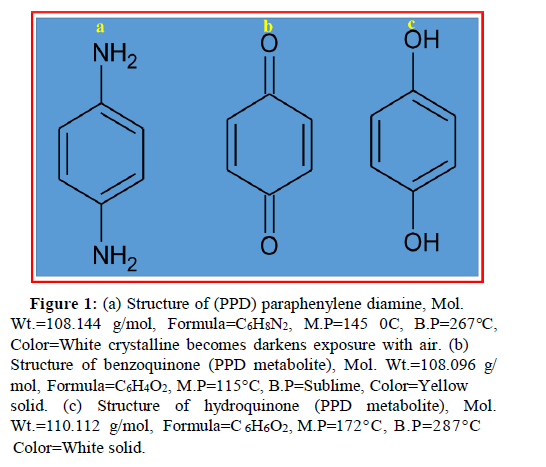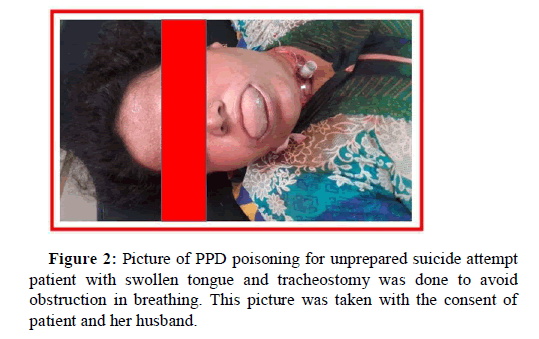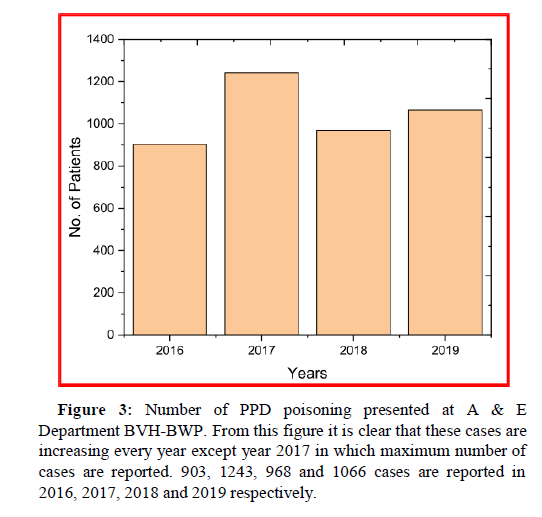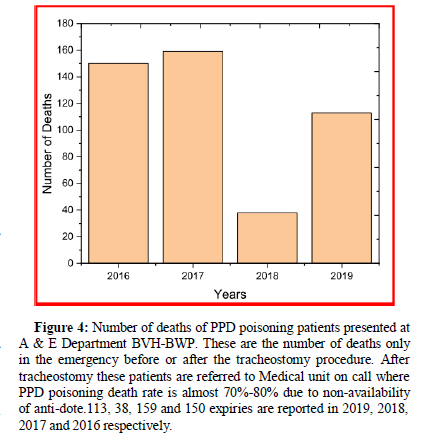Paraphenylene Diamine Toxicity â Epidemiology and Treatment in Rural Regions of Bahawalpur, Punjab, Pakistan
Received: 08-Mar-2021 / Accepted Date: 23-Mar-2021 / Published Date: 31-Mar-2021 DOI: 10.4172/2476-2067.1000152
Abstract
Aim and objective: The present study focuses on the toxicity of Para Phenylene Diamine (PPD) and case control study having intake of PPD orally. Further epidemiology of the PPD in Bahawalpur region is also discussed briefly.
Study design: Case control study is involved as well as epidemiology of PPD given concisely.
Methodology: It is a case control study. Study was conducted at Accident and Emergency Department Bahawal Victoria Hospital Bahawalpur (A&E-BVH-BWP), Punjab, Pakistan. One female patient taking PPD orally for suicide attempts was admitted in A&E-BVH-BWP. She was conscious having Glasgow Coma Scale (GCS) 10/15, irritating, feeling trouble in breathing, swollen tongue, edema on neck and face having saturation (SpO2) 72% with normal Blood Pressure (BP) 115/80 mmHg. Furthermore epidemiology of the PPD in the Bahawalpur region was also discussed briefly in which the patients from 2017 January to 2019 December were also discussed.
Results: PPD is applied extensively in quite a lot of industrialized goods, commonly recognized as Kala Pathar which is a type of aromatic amine. In addition PPD is also castoff by women’s and men’s as a hair colorant in addition with Henna Mahanadi (Lawsonia Alba). In 1924 a hair stylist was encountered first time incident of PPD owing acquaintance to PPD comprising hair dyes. In Western Nation States PPD toxicity is infrequent but in India, East Africa and Middle Eastern Nations this poisoning is worsening to a certain extent which is communal at these Republics. In Pakistan as well as in voluminous other States PPD has been turn out to be an incipient and life span threating cradle of poisoning. Angioedema of brain and neckline, soft and sublingual tissues necrosis, Rhabdomyolysis and ARF (Acute Renal Failure) are a number of pathologies which are instigated by PPD intake. The management strategy of PPD noxiousness is quite conventional, take account of tracheostomy and excessive diuresis to avert air route hindrance and respirational/renal failure, for the reason that of unapproachability/ unavailability of an antidote.
Conclusion: Familiar with etiological aspects, clinical sorts and upshots of patients with PPD poisoning are the ambitions of this study. In this study epidemiological of orally PPD assassinating was also deliberated at A&E-BVHBWP rural areas from Jan 2017-Dec 2019. Moreover this is unique study to give details about the mechanism and chemical metabolism as well as supporting treatment of PPD poisoning.
Keywords: PPD; Kala pathar; Suicidal attempts; Tracheostomy; Aniline derivative
Introduction
In many Asian countries suicide is considered as a legal issue and cause every year about 1 million deaths. In the developed and underdeveloped countries suicide rate is increased by 60% since last 10 years globally [1,2]. Major cause of overburden in many emergency departments is due to suicide attempts. Poisoning with PPD, pesticides, fire arms and hanging are the various methods used for suicide because of easily availability in the society. Among these PPD poisoning suicide rate is very striking and cause 80 to 90 percent deaths [3,4]. PPD chemically is derivative of para nitro aniline and aromatic amine derivative of aniline is frequently used in many industrial processes [5-7]. Hair dyes, photo chemical process, hair dye oxidation, dyeing furs, vulcanization of tyres and in rubber industry.
Because PPD have strong tendency to accelerates the die darker, dyeing process, hence used since 1863 by many women in cosmetic purpose mixed with Henna (Lawsonia Alba) in many countries like Africa, India, Middle East and Pakistan [8]. As of industrial importance and as dyeing agent PPD is extensively available in market having many common names like Kala Pathar, Black stone, Paramine, Ursol D, Furol S, Fouramine D and Vulpha D in Pakistan, India and Africa. Takaout Roumia and Takaout Beldia are the common name of PPD in Morocco where it is freely available in market derived from scab of Tamaris orientalists by traditional herbalist as a vegetal nontoxic product. Depending upon the nature of product concentration of PPD varies between 0.2 to 3.85% in these products [6-9]. The hair dye which is easily available in market having ingredients PPD, propylene glycol, Preservatives, perfumes, resorcinol and Sodium Ethylene Diamine Tetra Acetic Acid (EDTA-Na). From these ingredients PPD is reported as a major contributor of toxicity. The combined effects of the individual toxicants results in significant morbidity and mortality [10-12].From India and Pakistan PPD poisoning is reported as an emerging and important etiological factor in many studies. From 1990 to since date PPD poisoning is considered as a number one in Morocco, India, Pakistan and Africa [13]. In 1924 first case of PPD poisoning was reported in a hairdresser because of exposure to PPD containing hair dyes. Chugh reported for the first time 2 patients suffering oligo urea and Acute Renal Failure (ARF) due to PPD intoxification.in Sudan 31 patients reported due to PPD poisoning having severe angio neurotic edema in all the cases and 15 patients were given urgent tracheostomy, ARF patients were five and 13 patients died with-in 12 hours in the hospital. Now a days PPD poisoning becomes very common in Pakistan and India because of availability PPD easily in the market [14,15].When PPD is ingested orally for suicide purpose it causes rapidly development of edema on the face, pharynx, neck and larynx and tongue initially and later cause rhabdomyolysis [16]. Further it leads to angioedema, asphyxia, acute renal failure, IV hemolysis, toxic myocarditis, rhabdomyolysis, oliguria/anuria and dysphagia. Acute renal failure and myocardial damage leads to fatality [17]. Acute PPD poisoning also causes protruding tongue, brown color urine or retention of urine and ARF. Finally ARF supervenes as renal tubular necrosis occurs due to the deposits of the toxic metabolites of PPD and culminating in death if not treated aggressively. It can also cause acute hepatitis [18,19]. In emergency and ICU, PPD suicide cases in our hospital BVH-BWP has been greatly increased from last ten to 15 years and is likely to increase further. There are limited studies have been reported which documents the acute PPD toxicity, because of non-availability of specific biomarkers and anti-dote. The aim of this study was to recognize the etiological factors, clinical features and outcomes of PPD poisoning patients presenting in a tertiary care facility Bahawal Victoria Hospital Bahawalpur (BVH-BWP).
Case Presentation
Here the authors report a case of 32 years old women who ingested PPD after the aggression with her husband due to some domestic problems. She have three children’s two boys and one girl, small baby have 5 years of age and was not giving breast feeding to her child. Legal informed consent from patient’s first relatives was taken before including the patient’s admission in the A & E Department of BVH Bahawalpur. Patient presented with PPD poisoning before 3 hours after mixing with cold drink. At admission she had complaints of breathing difficulty, stridor and hoarseness of voice. Swelling of lips, tongue, neck and eyelids were the prominent physical findings. In addition, his tongue was extremely swollen and was protruding from mouth. Patient was first managed by giving IV fluids, diuretics, antihistamines and steroids; tracheal intubation/tracheostomy was done because her tongue and sublingual tissues were very much swollen and patient was too much irritating due to the obstruction in air way and breathing. Diagnosis of PPD poisoning was based on clinical presentation and on the information provided by the family members or the patients themselves. We recorded the patient’s clinical presentation, baseline parameters, laboratory profile, as well as outcomes, e.g. need of tracheostomy, mechanical ventilation, ICU stay and mortality.
The blood pressure was 115/80 mmHg, respiration and pulse rate was 37/min and 115/min. Blood biochemistry revealed severe metabolic acidosis (pH 6.9, bicarbonate 7.7 meq/L, PCO2 14.9 mmHg, PO2 140.5 mmHg), uraemia (creatinine 6.3 mg/dL, urea 130 mg/dl) with hypokalemia (serum potassium 2.7 meq/L) and muscle enzymes CPK (Creatine pospho kinase) 1288 U/I, CKMB 771 U/I, Aspartate Aminotransferase (AST), 195 U/L (normal 0-40 U/L); Alanine Aminotransferase (ALT), 46 U/L (normal 0-40 U/L); total serum creatine phosphokinase (CPK), 998 U/L (normal 32-294 U/L), CPKMB, 144 ng/mL (normal 0-3 ng/mL) and myoglobin 480 ng/mL (normal 17.4-105.7 ng/mL). Urine was dark brown colored, volume decreased to 30 ml/12 hr and showed positive for myoglobin. Urine ketones were negative (Figure 1).
Figure 1: (a) Structure of (PPD) paraphenylene diamine, Mol. Wt.=108.144 g/mol, Formula=C6H8N2, M.P=145 0C, B.P=267°C, Color=White crystalline becomes darkens exposure with air. (b) Structure of benzoquinone (PPD metabolite), Mol. Wt.=108.096 g/ mol, Formula=C6H4O2, M.P=115°C, B.P=Sublime, Color=Yellow solid. (c) Structure of hydroquinone (PPD metabolite), Mol. Wt.=110.112 g/mol, Formula=C6H6O2, M.P=172°C, B.P=287°C Color=White solid.
On his second day while his supportive treatment was going on, she was admitted to intensive care unit of BVH in Bahawalpur. The idea of plasma pheresis or dialysis may be required and performed in the kidney center of BVH Bahawalpur. In addition to fluid replacement therapy, adrenaline, antihistamine and dexamethasone were given to the patient. The next day, her edema resolved and she recovered consciousness.
On the third day of treatment, her serum AST, ALT, LDH, CPK and CPK-MB levels almost turn out to be average and his urine color became normal. During follow-up, the patient did not show rise in serum urea and creatinine, and oliguria was not observed. She was discharged with full consciousness, his edema was totally resolved, and his all blood tests were in normal values. However, she could not breathe spontaneously without tracheostomy. Thus, tracheostomy was not removed and her family members were trained about tracheostomy care and aspiration before discharge. After 3 days she was presented in the A & E BVH which was breathing normally and tracheostomy was removed and retained in the A & E BVH for about 3 to check any difficulty in breathing, after 3 hours she was discharged from hospital (Figure 2).
Besides this case the number of admitted cases in A&E department BVH-BWP are 4180 out of these 460 patients were died before or after tracheostomy in the A & E department due to acute PPD poisoning and other patients were shifted in medical wards after tracheostomy to overcome the PPD poisoning to save lives.
Results
The results of our study reveal that the PPD (Kala Pathar) poisoning has become one of the main means of suicide attempts in our country Pakistan having very high mortality rate. At the time of presentation mostly dysphagia, cardiogenic edema, acute renal failure, hyperkalemia, and brown/black color urine are the some important predictors which predicts the PPD poisoning. This poisoning severely cause obstruction and irritation in breathing and tracheostomy procedure is very effective and life-saving trials in these patients to relieve obstruction and irritation. In A & E Department of BVH-BWP the number of patients presented were 4180 since from January 2019 to December 2016 in which 1066, 968, 1243 and 903 patients were reported in 2016, 2017, 2018 and 2019 (Figure 3). The number of patients that were expired from PPD poisoning in the emergency are 113, 38, 159 and 150 in year 2019 to 2016 (Figure 4). These are the patients which were expired due to PPD poisoning at the time of arrival in the A & E department before or after the tracheostomy procedure.
Figure 4: Number of deaths of PPD poisoning patients presented at A & E Department BVH-BWP. These are the number of deaths only in the emergency before or after the tracheostomy procedure. After tracheostomy these patients are referred to Medical unit on call where PPD poisoning death rate is almost 70%-80% due to non-availability of anti-dote.113, 38, 159 and 150 expiries are reported in 2019, 2018, 2017 and 2016 respectively.
Discussion and Conclusion
PPD ingestion grounds warning sign get up on or after involvement of diverse organs. It is the derived form of aniline in nature chemically. It is slightly or partially soluble in water but in acidic media completely soluble in water and easily solubilized in peroxide (H2O2) and having black or brown appearance. PPD is metabolized using a radical cytochrome P450 peroxidase resulting in the formation of a reactive compound benzoquinone diamine, because PPD have a donor property and easily donates its proton to cytochrome P450 peroxidase. Benzoquinone diamine takes place further oxidation to form a trimer known as Brandowaski’s base (hydroquinone), reported to having well known property to cause anaphylaxis, inflammation of liver and mutation.
Recommendations
It is by tradition hand-me-down for change the color of palms and soles along with henna and to tint the tresses as well. PPD quickens the staining process. Color dyes are frequently used for unprepared suicide endeavors. Governments prerequisite to proceeds a lawful achievement to stopover the jumble sale of this deadly toxin and attentiveness amongst populates in vulnerable bazaars under the brand of a hair dye which is the merely safest approach to acquire free of PPD assassinating.
Moreover no particular anti-dote and biomarker is accessible for PPD toxicity consequently it is recommended to the investigators to discover unambiguous anti-dote and biomarker for this poisoning. As there is no specific antidote existing for this poisoning only supporting techniques like washing the mouth by means of liquid (water) and swallowing milk may relieve the gastrointestinal warning sign. Digestive lavage using 2% sodium bicarbonate is correspondingly operative. In line for to truncated molecular weight and hydrophilic environment, PPD devises certain comparable absorbability on activated charcoal. Insignificant case of respirational contribution can be accomplished by means of chloro-pheniramine maleate and hydrocortisone. Acute respiratory distress necessitates ventilator maintenance. Alkalization of urine is also operational once hemoglobinuria is perceived.
Acknowledgement
The authors are very grateful to the Accident & Emergency Department Bahawal Victoria Hospital Bahawalpur and The Islamia University of Bahawalpur for providing necessary facilities to complete this work.
Conflict of Interest
None
Ethical Approval
The study was conducted by the approval of ethical committee of The Quaid-E-Azam Medical College (QMC) Bahawalpur, and The Islamia University of Bahawalpur (IUB).
Funding’s
No funding is awarded for this study.
References
- Abdel-Moneim A (2017) Acute toxicity by hair dye in upper Egypt. Int J Forensic Sci Pathol 5: 305-311.
- Rani, Geetha A, Bhuvaneshwaran B, Inba I (2020) Incidence and pattern of poisoning cases admitted in a tertiary care center. Natl J Physiol Pharm Pharmacol 10: 309-312.
- Akl A, Alturki R (2018) Paraphenylenediamine hair dyeing nephropathy: a case report and review of literature. Urol Nephrol Open Access J 6: 147-149.
- Beshir L,Kaballo B,Young D (2017) Attempted suicide by ingestion of hair dye containing p-phenylenediamine: A case report. Ann Clin Biochem 54: 507-510.
- Almeida P,Borrego L, Melián E, DÃaz O (2012) Quantification of p-phenylenediamine and 2-hydroxy-1, 4-naphthoquinone in henna tattoos. Contact Dermatitis 66: 33-37.
- Ashar A (2003) Acute angioedema in paraphenylenediamine poisoning. J Pak Med Assoc 53: 120-122.
- Chaudhari V, Kumaran M, MittalHair C, Srinivas B, Shaha K (2017) Hair dye poisoning and the toxic effects of paraphenylenediamine. J Indian Soc Toxicol 13: 37-40.
- Khaskheli M, Shaikh S, Meraj M, Raza H, Aslam I (2019) Paraphenylenediamine poisoning: clinical features, complications and outcome in a tertiary care institute. Anesth Intensive Care 22: 343-347.
- Anuradha S, Arora S, Mehrotra S, Arora A, Kar P (2004) Acute renal failure following para-phenylenediamine (PPD) poisoning: A case report and review. Ren Fail 26:329-332.
- Chaudhary S, Sawlani K, Singh K (2013) Paraphenylenediamine poisoning. Niger J Clin Pract 16: 258-259.
- Devi M (2016) Toxicological effects of hair dye paraphenylene diamine: A threat to cosmetic world. Int J Res Anal Rev 3: 19-23.
- Haider S (2018) Paraphenylenediamine poisoning: clinical presentations and outcomes. Anesth Intensive Care 22: 43-47.
- Hashim MS, Hamza YO, Yahia B, Khogali FM, Sulieman GI (1992) Poisoning from henna dye and para-phenylenediamine mixtures in children in Khartoum. Ann Trop Paediatr 12: 3-6.
- Hooff GP, Huizen N, Meesters R, Zijlstra E, Abdelraheem M (2011) Analytical investigations of toxic p-phenylenediamine (PPD) levels in clinical urine samples with special focus on MALDI-MS/MS. PloS One 6: e22191.
- Khan MA, Akram S, UsmanShah H, Hamdani SA, Khan M (2018) Epidemic of kala pathar (paraphenylene diamine) poisoning: An emerging threat in southern Punjab. J Coll Physicians Surg Pak 28: 44-47.
- Khuhro BA, Khaskheli MS, Shaikh AA (2019) Paraphenylene diamine poisoning: Our experience at PMC Hospital Nawabshah. Anesth Intensive Care 16: 243-246.
- Shafiq M, Faran M, Iqbal A, Baqai HZ (2015) Kala Pathar†poisoning. Journ Rawal Med Coll 19: 98-99.
- Singla S, Miglani S, Lal AK,Gupta P, Agarwa AK (2005) Para-phenylenediamine (PPD) poisoning. J Indian Acad Clin Med 6: 236-238.
- Yagi H, el Hind AM, Khalil SI (1991) Acute poisoning from hair dye. East Afr Med J 68: 404-411.
Citation: Khalil Ahmad (2021) Paraphenylene Diamine Toxicity – Epidemiology and Treatment in Rural Regions of Bahawalpur, Punjab, Pakistan. Toxicol Open Access 7:152. DOI: 10.4172/2476-2067.1000152
Copyright: © 2021 Ahmad K. This is an open-access article distributed under the terms of the Creative Commons Attribution License, which permits unrestricted use, distribution, and reproduction in any medium, provided the original author and source are credited.
Select your language of interest to view the total content in your interested language
Share This Article
Open Access Journals
Article Tools
Article Usage
- Total views: 10048
- [From(publication date): 0-2021 - Dec 05, 2025]
- Breakdown by view type
- HTML page views: 8921
- PDF downloads: 1127




